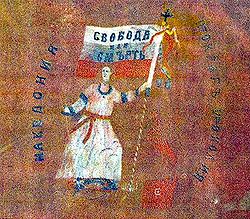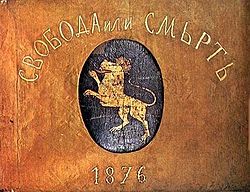Talk:Liberty or death
| Disambiguation | ||||
| ||||
Macedonian motto?[edit]
Serbian slogan "Sloboda ili smrt" was never used by the insurgents during the Ilinden uprising. Macedonian language was standartized in 1945. The insurgents from 1903 and later wrote only in Bulgarian. Please stop disruptive editing and falsifying the historical circumstances. Thanks. Jingiby (talk) 12:26, 17 March 2018 (UTC)
- Left below is the banner of the insurgents from Ohrid during the Ilinden uprising from 1903. The banner has the Bulgarian flag on it.[1] The inscription Свобода или смърть is also visible in Bulgarian. The insurgents flew Bulgarian flags everywhere.[2] Right below is also IMRO merit badge from 1920-s. The inscription in Bulgarian is clearly visible: Свобода или смърть. The flag of the April Uprising from 1876 right below has the same inscription in Bulgarian: Свобода или смърть'. Jingiby (talk) 13:01, 17 March 2018 (UTC)
- The Internal Macedonian Revolutionary Organization was inspired by Bulgarian freedom fighters, and adoptied the "Liberty or Death" slogan beloved of earlier Bulgarian insurgents, IMRO revolutionaries clearly saw themselves as the inheritors of Bulgarian revolutionary traditions and identified as Bulgarians.[3] The Macedonian Revolutionary Organization used the Bulgarian standard language in all its correspondence, programmatic statements and so on. In fact the organization was called initially Bulgarian Macedonian-Adrianople Revolutionary Committees, its correspondence was solely in the Bulgarian language, nearly all of its leaders were Bulgarian teachers or Bulgarian officers, and received financial and military help tfrom Bulgaria. After 1944 all the literature of Macedonian writers, memoirs of Macedonian leaders, and important documents had to be translated from Bulgarian into the newly invented Macedonian. Please stop manipulating history.[4] Jingiby (talk) 19:16, 17 March 2018 (UTC)
- IMRO group modeled itself after the revolutionary organizations of Vasil Levski and other noted Bulgarian revolutionaries like Hristo Botev and Georgi Benkovski, each of whom was a leader during the earlier Bulgarian revolutionary movement. Around this time ca. 1894, a seal was struck for use by the Organization leadership; it was inscribed with the phrase "Freedom or Death" (Svoboda ili smurt).[5] Not as in Serbian/codified in 1945 Macedonian: Sloboda ili smrt. Jingiby (talk) 19:50, 17 March 2018 (UTC)
- According to American researcher Dennis P. Hupchick, who is an expert on Balkan history: "The obviously plagiarized historical argument of the Macedonian nationalists for a separate Macedonian ethnicity could be supported only by linguistic reality, and that worked against them until the 1940s. Until a modern Macedonian literary language was mandated by the communist-led partisan movement from Macedonia in 1944, most outside observers and linguists agreed with the Bulgarians in considering the vernacular spoken by the Macedonian Slavs as a western dialect of Bulgarian".[6] More, Blaže Koneski who was the main contributor to the codification of standard Macedonian was born into a distinguished [sic] Serboman family and today some historians in the Republic of Macedonia, have described the process of codifying the Macedonian language as 'Serbianization'.[7] Because of that Bulgarian motto Свобода или смърть was transformed after 1944 to Слобода или смрт, which is identical to the motto of the Serbian Chetniks: Слобода или смрт. That modern Macedonian version was not used during the Ilinden Uprising. Jingiby (talk) 15:34, 18 March 2018 (UTC)
- IMRO group modeled itself after the revolutionary organizations of Vasil Levski and other noted Bulgarian revolutionaries like Hristo Botev and Georgi Benkovski, each of whom was a leader during the earlier Bulgarian revolutionary movement. Around this time ca. 1894, a seal was struck for use by the Organization leadership; it was inscribed with the phrase "Freedom or Death" (Svoboda ili smurt).[5] Not as in Serbian/codified in 1945 Macedonian: Sloboda ili smrt. Jingiby (talk) 19:50, 17 March 2018 (UTC)
- The Internal Macedonian Revolutionary Organization was inspired by Bulgarian freedom fighters, and adoptied the "Liberty or Death" slogan beloved of earlier Bulgarian insurgents, IMRO revolutionaries clearly saw themselves as the inheritors of Bulgarian revolutionary traditions and identified as Bulgarians.[3] The Macedonian Revolutionary Organization used the Bulgarian standard language in all its correspondence, programmatic statements and so on. In fact the organization was called initially Bulgarian Macedonian-Adrianople Revolutionary Committees, its correspondence was solely in the Bulgarian language, nearly all of its leaders were Bulgarian teachers or Bulgarian officers, and received financial and military help tfrom Bulgaria. After 1944 all the literature of Macedonian writers, memoirs of Macedonian leaders, and important documents had to be translated from Bulgarian into the newly invented Macedonian. Please stop manipulating history.[4] Jingiby (talk) 19:16, 17 March 2018 (UTC)




Sloboda ili smert is both a Macedonian and Bulgarian battle cry. To ignore it would to erase a vital piece of Macedonia's history. The images that you have listed are clear Bulgaro-centric and Bulgaro-phile propaganda which can be clearly seen as racist towards Macedonians as most/many Bulgarians do not view Macedonians as a separate cultural entity but as a part of the Bulgarian race. This flagrantly untrue as Macedonians are their own cultural entity and in reality close to the Serbian race. The fake lies that the Krushevo Republic was only created by Tito and his administration to strengthen Yugoslav claims on Bulgarian land are extremely discriminatory and evidently racist. They were only created as lies to diminish the historical claims of an already weak people group i.e. the Macedonians Wikipedia's policies of a neutral point of view are clear that the article should not contain a bias such as calling a certain race subhuman or saying that their history does not exist. Therefore, how is it neutral to completely deny the history of the Republic of Macedonia and its citizens? 68.149.124.43 (talk) 04:26, 5 December 2018 (UTC)
- I realized that no sources were provided. Only POV. Primary and secondary sources above are clear that Sloboda ili smert was never used as a slogan by Macedono-Bulgarian revolutionaries. Reliable sources tell another story:
- "Yugoslav Communists recognized the existence of a Macedonian nationality during WWII to quiet fears of the Macedonian population that a communist Yugoslavia would continue to follow the former Yugoslav policy of forced Serbianization. Hence, for them to recognize the inhabitants of Macedonia as Bulgarians would be tantamount to admitting that they should be part of the Bulgarian state. For that the Yugoslav Communists were most anxious to mold Macedonian history to fit their conception of Macedonian consciousness. The treatment of Macedonian history in Communist Yugoslavia had the same primary goal as the creation of the Macedonian language: to de-Bulgarize the Macedonian Slavs and to create a separate national consciousness that would inspire identification with Yugoslavia."[8]
- "The obviously plagiarized historical argument of the Macedonian nationalists for a separate Macedonian ethnicity could be supported only by linguistic reality, and that worked against them until the 1940s. Until a modern Macedonian literary language was mandated by the communist-led partisan movement from Macedonia in 1944, most outside observers and linguists agreed with the Bulgarians in considering the vernacular spoken by the Macedonian Slavs as a western dialect of Bulgarian".[9]
- The political and military leaders of the Slavs of Macedonia at the turn of the 20 century seem not to have heard the call for a separate Macedonian national identity; they continued to identify themselves in a national sense as Bulgarians rather than Macedonians.[...] (They) never seem to have doubted “the predominantly Bulgarian character of the population of Macedonia". "[10]
- Initially the membership in the IMRO was restricted only for Bulgarians. Its first name was "Bulgarian Macedonian-Adrianople Revolutionary Committees", which was later changed several times. IMRO was active not only in Macedonia but also in Thrace (the Vilayet of Adrianople). Since its early name emphasized the Bulgarian nature of the organization by linking the inhabitants of Thrace and Macedonia to Bulgaria, these facts are still difficult to be explained from the Macedonian historiography.[11]
- The origins of the official Macedonian national narrative are to be sought in the establishment in 1944 of the Yugoslav Republic of Macedonia. This open acknowledgment of the Macedonian national identity led to the creation of a revisionist historiography whose goal has been to affirm the existence of the Macedonian nation through the history. Macedonian historiography is revising a considerable part of ancient, medieval, and modern histories of the Balkans.[12]
- "No doubt, the vast majority of the Macedonian peasants, being neither communists nor members of IMRO (United), had not been previously affected by Macedonian national ideology. The British officials who attempted to tackle this issue in the (late) 1940s noted the pro-Bulgarian sentiment of many peasants and pointed out that Macedonian nationhood rested ‘on rather shaky historical and philological foundations’ and, therefore, had to be constructed by the Macedonian leadership."[13] Jingiby (talk) 10:21, 5 December 2018 (UTC)
References[edit]
- ^ National military history museum of Bulgaria, fond 260
- ^ Who are the Macedonians by Hugh Poulton - p. 57. Retrieved 29 November 2014.
- ^ Jonathan Bousfield, Dan Richardson, Bulgaria, Rough Guides, 2002, ISBN 1858288827, p. 450.
- ^ Bernard A. Cook ed., Europe Since 1945: An Encyclopedia, Volume 2, ISBN 0815313365, Taylor & Francis, 2001, ISBN 0815340583, p. 808.
- ^ Duncan M. Perry, The Politics of Terror: The Macedonian Liberation Movements, 1893-1903, Duke University Press, 1988, pp. 39-40.
- ^ Dennis P. Hupchick, Conflict and Chaos in Eastern Europe, Palgrave Macmillan, 1995, p. 143.
- ^ Tchavdar Marinov, Historiographical Revisionism and Re-Articulation of Memory in the Former Yugoslav Republic of Macedonia in FONDS D'ANALYSE DES SOCIÉTÉS POLITIQUES, May 2010, Issue 25, p. 7.
- ^ Stephen E. Palmer, Robert R. King, Yugoslav communism and the Macedonian question, Archon Books, 1971, ISBN 0208008217, Chapter 9: The encouragement of Macedonian culture.
- ^ Dennis P. Hupchick, Conflict and Chaos in Eastern Europe, Palgrave Macmillan, 1995, p. 143.
- ^ "The Macedonian conflict: ethnic nationalism in a transnational world", Princeton University Press, Danforth, Loring M. 1997, ISBN 0691043566, p. 64.
- ^ Brunnbauer, Ulf (2004) Historiography, Myths and the Nation in the Republic of Macedonia. In: Brunnbauer, Ulf, (ed.) (Re)Writing History. Historiography in Southeast Europe after Socialism. Studies on South East Europe, vol. 4. LIT, Münster, pp. 165-200.
- ^ Victor Roudometof, Collective Memory, National Identity, and Ethnic Conflict: Greece, Bulgaria, and the Macedonian Question, Greenwood Publishing Group, 2002, ISBN 0275976483, p. 58;
- ^ Livanios, D. (2008), The Macedonian Question: Britain and the Southern Balkans 1939-1949.: Oxford University Press, ISBN 0191528722, p. 206.

